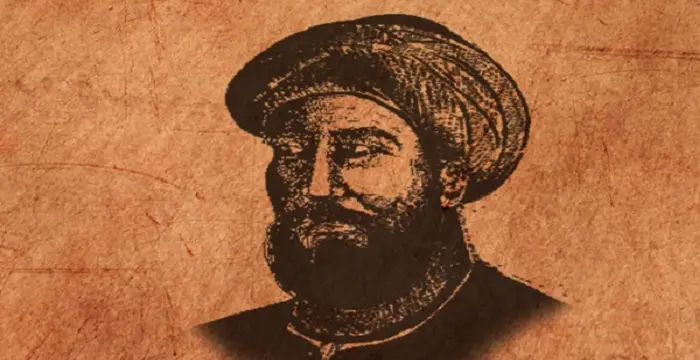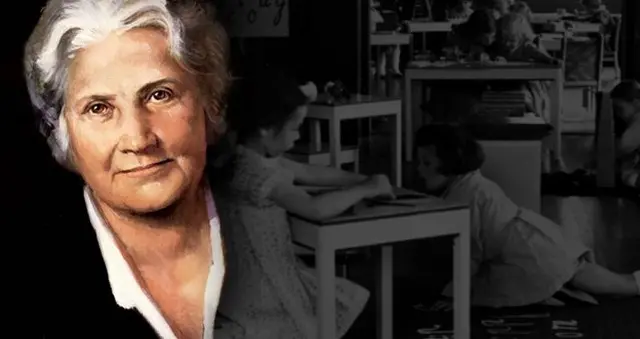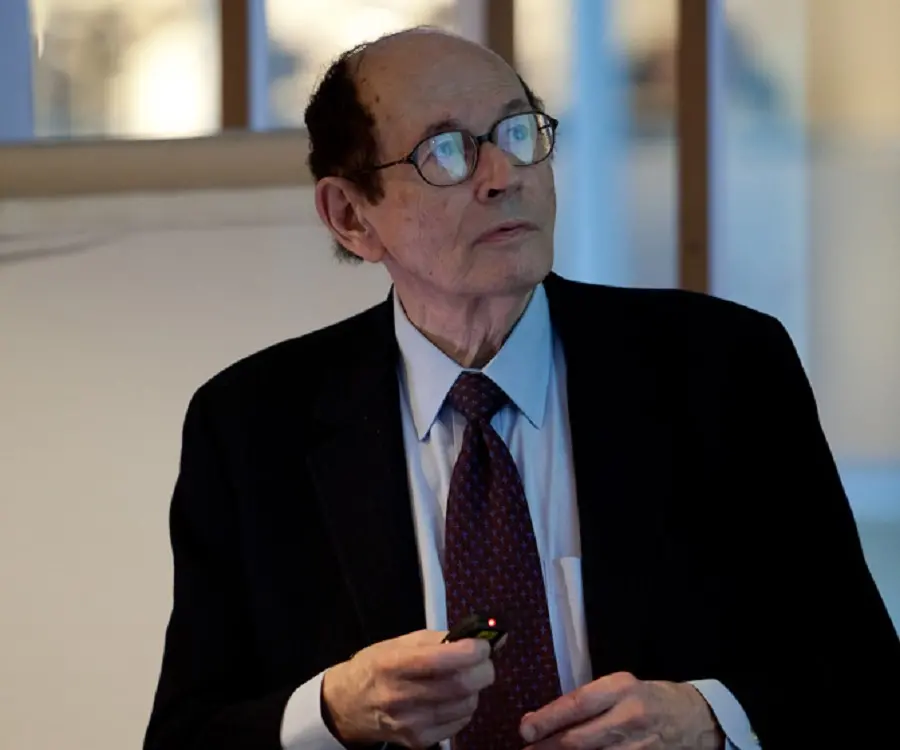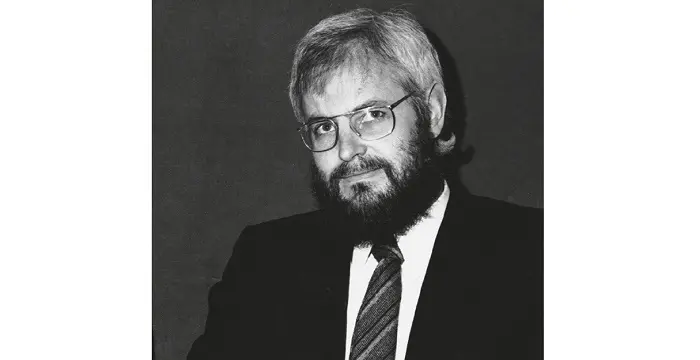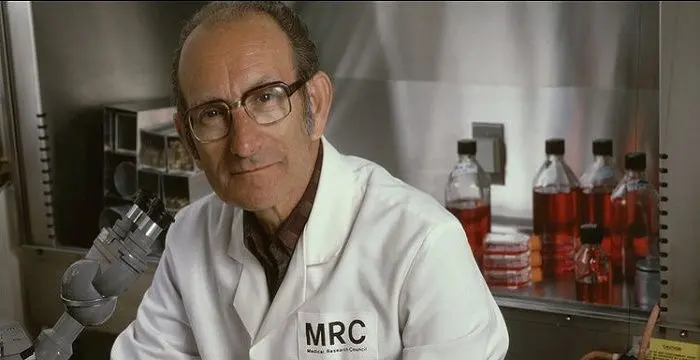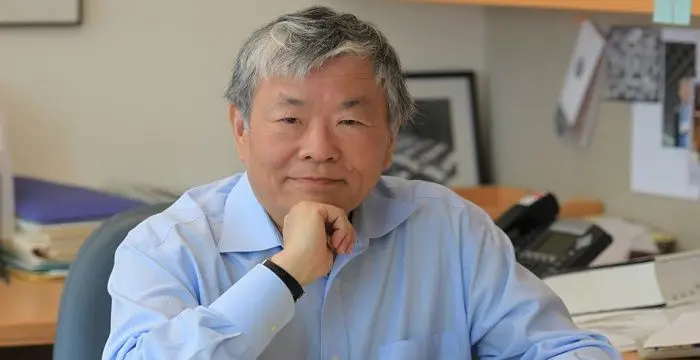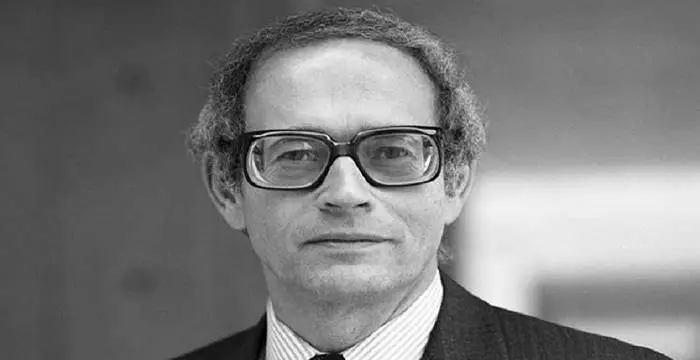
Gerald Edelman - Immunologists, Facts and Personal Life
Gerald Edelman's Personal Details
Gerald Edelman was a noted American Immunologist who, along with Rodney Robert Porter, won the 1972 Nobel Prize in Physiology or Medicine
| Information | Detail |
|---|---|
| Birthday | July 1, 1929 |
| Died on | May 17, 2014 |
| Nationality | American |
| Famous | Physicians, Immunologists |
| Birth Place | Ozone Park, New York City, New York, United States |
| Gender | Male |
| Sun Sign | Cancer |
| Born in | Ozone Park, New York City, New York, United States |
| Famous as | Immunologist |
| Died at Age | 84 |
// Famous Physicians
Al-Zahrawi
Al-Zahrawi, was an illustrious medieval Arab Muslim physician and surgeon. Check out this biography to know about his childhood, family life, achievements and interesting facts about him.
Jabir Ibn Hayyan
Jabir Ibn Hayyan was a medieval era polymath. Check out this biography to know about his life, works and achievements.
Maria Montessori
Maria Montessori was a physician and educator who developed the approach of Montessori education. This biography of Maria Montessori provides detailed information about her childhood, life, achievements, works & timeline.
Gerald Edelman's photo
Who is Gerald Edelman?
Gerald Edelman was a noted American Immunologist who, along with Rodney Robert Porter, won the 1972 Nobel Prize in Physiology or Medicine. The duo won the Nobel Prize for their discovery of the structure of antibody molecules. Initially, Edelman wanted to be a concert vocalist; but later made up his mind to become a doctor. However, while working in U.S. Army Medical Corp in Paris he read a book about immunology, which sparked an interest in antibodies in him. So, he went back to America to join Rockefeller institute for his Ph.D. degree. He then worked on antibodies, which he found were made up of chains of amino acids held together by disulfide bonds. He made exact replica of an antibody and explained how the body produces them in response to antigens. The work not only earned him the Nobel Prize, but also opened the door for further investigations. Later, he started working on primary cellular process and discovered cell adhesion molecules, which binds cells together to form tissues. He then began to work on how the brain gives rise to the mind and established the theory of Neuronal Group Selection, also known as ‘Neural Darwinism’. He also authored number of books, in some of which he had also explained his ideas to layman.
// Famous Immunologists
Georges J. F. Kohler
Georges J. F. Kohler was a German immunologist who received the Nobel Prize in Physiology or Medicine in 1984. Check this biography to get details about his life, profile and timeline.
Cesar Milstein
Cesar Milstein was an Argentinian biochemist who received the Nobel Prize for his discovery of monoclonal antibody. Explore this biography to get details about his life, career and scientific discoveries.
Susumu Tonegawa
Susumu Tonegawa is a Japanese molecular biologist who was awarded the Nobel Prize for Physiology or Medicine in 1987. This biography of Susumu Tonegawa provides detailed information about his childhood, life, achievements, works & timeline.
Childhood & Early Life
Gerald Edelman was born on July 1, 1929, in Ozone Park, New York City. His father, Edward Edelman, was a practicing physician while his mother, Anna (née Freedman) Edelman, was employed in the insurance industry.
Young Gerald had his schooling at John Adam High School in Queens, New York City. Since his ambition was to become a concert violinist he also took training under noted teacher cum performer Albert Meiff.
At sixteen, Gerald realized that he did not have the required drive to become a professional violinist and decided to follow his father’s footstep and study medicine. So, after passing out from school in 1946, he enrolled at Ursinus College in Collegeville, Pennsylvania.
In 1950, he graduated magna cum laude with a B.S. degree in chemistry and entered the University Of Pennsylvania School Of Medicine. He received his M.D. in 1954. In 1955, he completed his internship at Johnson Foundation for Medical Physics and joined Massachusetts General Hospital as a medical house officer.
Later in the same year, he joined the U.S. Army Medical Corps as a captain, and for two years, practiced general medicine at military hospital in Paris. His interest in antibodies was ignited during this period and he decided to investigate more into it.
Therefore, on returning home in 1957, he joined the Rockefeller Institute for Medical Research as a graduate fellow. Here he explored on the ways of splitting immunoglobulin molecules under Henry Kunkel, ultimately receiving a Ph.D. in 1960.
Career
In 1960, Edelman was appointed as Assistant Dean of Graduate Studies at the Rockefeller Institute for Medical Research. In 1963, he was promoted to the post of Associate Dean of Graduate Studies and then from 1966 to 1992, he served as a full professor at the same Institute.
At this time, not much was known about the chemical structure of antibodies. Although by then, it was established that they combated antigens, it was not clear how they recognized them. While working at Rockefeller Institute Edelman began his research on that.
He realized that antibodies were made up of two light and two heavy amino acid chains, linked together by disulfide bonds. In 1969, Edelman was able to spilt these antibodies and create an exact model. Later, he also pin pointed the precise position of antigenic binding and explained the mode of their functioning.
Subsequently, Edelman’s interest took a different direction. He began to wonder how one single fertilized cell turns into a multi-cellular organism. He therefore started working on primary cellular process, focusing especially on the interaction in cells and formation of nervous system in the early stages of embryonic development.
In 1975, he discovered a new type of protein called ‘cell adhesion molecules’ or CAMs and established that, as the brain develops, these CAMs bind the neurons together to form its basic circuit. Later it was established that CAMs help organism to achieve its shape and also to build its nervous system.
Soon he began to investigate into ‘how the brain gives rise to the mind’. He rejected the prevalent idea that brains works like a computer. Instead, he took up a new direction, applying many of the insights he had obtained while working on antibodies.
Subsequently, he established the theory of Neuronal Group Selection (NGS), which deals in development and function of the brain. It later began to be known as ‘Neural Darwinism’. In 1978, he presented his ideas in his first technical book titled ‘The Mindful Brain’.
In 1981, he founded Neurosciences Institute under Rockefeller University and became its founder director. Here he continued working on the brain and in 1987, he enlarged his theory, publishing it under the title of ‘Neural Darwinism: The Theory of Neuronal Group Selection’.
Although his theory was criticized by many contemporary scientists, he did not give up. Subsequently, he wrote two more books to establish his hypothesis; i.e. ‘Topobiology: An Introduction to Molecular Embryology’ (1988) and ‘The Remembered Present: A Biological Theory of Consciousness’ (1989).
Later, he wrote number of books explaining his ideas to general readers. They include ‘Bright Air, Brilliant Fire’ (1992), ‘A Universe of Consciousness’ (2001, with Giulio Tononi), ‘Wider than the Sky’ (2004) and ‘Second Nature: Brain Science and Human Knowledge’ (2007).
Meanwhile in 1993, Edelman moved The Neuroscience Institute (TNI) to San Diego, California. It was first housed in a temporary address, but in 1995, it shifted to its own complex in the campus of Scripps Research Institute. Here, he actively participated in various research works almost until his death in 2014.
Major Works
Edelman is best remembered for his research on molecular immunology. He hypothesized that antibodies consisted of multiple amino acid chains held together by disulfide bonds. He dissolved these bonds and separated the antibodies in order to identify their components.
Subsequently, he found that antibodies were made up of two heavy and two light chains consisting of 1300 amino acids. Next he located the antigen-binding (variable) regions and effector function-conferring (constant) regions. Finally he produced the exact replica of an antibody.
He also established that all antibodies have the same basic structure. When different antigens attack our body, it produces diverse materials, generated in combination of various gene segments. The right antibody, selected from these materials, quickly multiplies to form the immune system.
This discovery provided a great insight into the structure and functions of antibodies. It also opened the door for further studies, which in turn had a far reaching effect on medical science.
Awards & Achievements
In 1972, Gerald Edelman received the Nobel Prize in Physiology or Medicine for his discovery "concerning the chemical structure of antibodies". He shared this prize with English biochemist Rodney R. Porter, who worked on it separately in England.
Edelman was also a member of many distinguished scientific societies like the National Academy of Sciences, the American Academy of Arts and Sciences, the American Society of Biological Chemists and the American Association of Immunologists.
Personal Life & Achievements
In 1950, Gerald Edelman married Maxine M. Morrison. The couple had three children. While the eldest son, Eric, is a visual artist in New York, daughter Judith is a well-known bluegrass vocalist. Only their second child, David, followed his father’s footstep and became an adjunct professor of neuroscience at University of San Diego.
Towards the end of his life, Edelman developed prostate cancer and Parkinson's disease. He died on May 17, 2014 in La Jolla, California. He was then 84 years old.
Trivia
While Edelman was trying to recreate the structure of the antibody at Rockefeller Institute, English biochemist Rodney R. Porter was also working on the same subject separately in England. Ultimately Edelman’s team was able to beat the English team at a narrow margin. However, the Nobel Foundation recognized both the works and awarded both of them for their achievements.
// Famous Cancer Celebrities peoples
Jacob Elordi
Jacob Elordi is an Australian actor. Let’s take a look at his childhood, family, personal life, career, etc.
Riele Downs
Riele Downs is a Canadian-American actress & Musical.ly star. Let’s take a look at her family and personal life including age, birthday, net worth, boyfriends and fun facts.
Yammy Xox
Check out all that you wanted to know about Yammy Xox, the famous British YouTube Personality; her birthday, her family and personal life, her boyfriends, fun trivia facts and more.
Gerald Edelman's awards
| Year | Name | Award |
|---|---|---|
Other | ||
| 0 | Nobel Prize in Physiology or Medicine | |
Gerald Edelman biography timelines
- // 1300Subsequently, he found that antibodies were made up of two heavy and two light chains consisting of 1300 amino acids. Next he located the antigen-binding (variable) regions and effector function-conferring (constant) regions. Finally he produced the exact replica of an antibody.
- // 1st Jul 1929Gerald Edelman was born on July 1, 1929, in Ozone Park, New York City. His father, Edward Edelman, was a practicing physician while his mother, Anna (née Freedman) Edelman, was employed in the insurance industry.
- // 1946At sixteen, Gerald realized that he did not have the required drive to become a professional violinist and decided to follow his father’s footstep and study medicine. So, after passing out from school in 1946, he enrolled at Ursinus College in Collegeville, Pennsylvania.
- // 1950In 1950, Gerald Edelman married Maxine M. Morrison. The couple had three children. While the eldest son, Eric, is a visual artist in New York, daughter Judith is a well-known bluegrass vocalist. Only their second child, David, followed his father’s footstep and became an adjunct professor of neuroscience at University of San Diego.
- // 1957 To 1960Therefore, on returning home in 1957, he joined the Rockefeller Institute for Medical Research as a graduate fellow. Here he explored on the ways of splitting immunoglobulin molecules under Henry Kunkel, ultimately receiving a Ph.D. in 1960.
- // 1969He realized that antibodies were made up of two light and two heavy amino acid chains, linked together by disulfide bonds. In 1969, Edelman was able to spilt these antibodies and create an exact model. Later, he also pin pointed the precise position of antigenic binding and explained the mode of their functioning.
- // 1972In 1972, Gerald Edelman received the Nobel Prize in Physiology or Medicine for his discovery "concerning the chemical structure of antibodies". He shared this prize with English biochemist Rodney R. Porter, who worked on it separately in England.
- // 1975In 1975, he discovered a new type of protein called ‘cell adhesion molecules’ or CAMs and established that, as the brain develops, these CAMs bind the neurons together to form its basic circuit. Later it was established that CAMs help organism to achieve its shape and also to build its nervous system.
- // 1978Subsequently, he established the theory of Neuronal Group Selection (NGS), which deals in development and function of the brain. It later began to be known as ‘Neural Darwinism’. In 1978, he presented his ideas in his first technical book titled ‘The Mindful Brain’.
- // 1981 To 1987In 1981, he founded Neurosciences Institute under Rockefeller University and became its founder director. Here he continued working on the brain and in 1987, he enlarged his theory, publishing it under the title of ‘Neural Darwinism: The Theory of Neuronal Group Selection’.
- // 1988 To 1989Although his theory was criticized by many contemporary scientists, he did not give up. Subsequently, he wrote two more books to establish his hypothesis; i.e. ‘Topobiology: An Introduction to Molecular Embryology’ (1988) and ‘The Remembered Present: A Biological Theory of Consciousness’ (1989).
- // 17th May 2014Towards the end of his life, Edelman developed prostate cancer and Parkinson's disease. He died on May 17, 2014 in La Jolla, California. He was then 84 years old.
// Famous American peoples
Wentworth Miller
Wentworth Miller is an American actor and screenwriter who achieved recognition for his role in the TV series ‘Prison Break’.
Jason Simpson
Jason Simpson is the son of former NFL running back, broadcaster and actor O. J. Simpson. Check out this biography to know about his childhood, family, life, and little known facts about him.
Melissa Brim
Melissa Brim is the ex-girlfriend of former professional boxer Floyd Mayweather Jr. Check out this biography to know about her birthday, childhood, family life, achievements and fun facts about her.
Skai Jackson
Skai Jackson is an American child actress with huge fan following. Find more about her family & personal life, relationships, facts and more.
Joyce Meyer
Joyce Meyer is a Christian author and speaker. This biography provides detailed information about her childhood, life, achievements, works & timeline
Zoe LaVerne
Zoe LaVerne is an American musical.ly star. Check out this biography to know more about her family, personal life, including her age, birthday, etc.
Gerald Edelman's FAQ
What is Gerald Edelman birthday?
Gerald Edelman was born at 1929-07-01
When was Gerald Edelman died?
Gerald Edelman was died at 2014-05-17
Which age was Gerald Edelman died?
Gerald Edelman was died at age 84
Where is Gerald Edelman's birth place?
Gerald Edelman was born in Ozone Park, New York City, New York, United States
What is Gerald Edelman nationalities?
Gerald Edelman's nationalities is American
What is Gerald Edelman's sun sign?
Gerald Edelman is Cancer
How famous is Gerald Edelman?
Gerald Edelman is famouse as Immunologist
